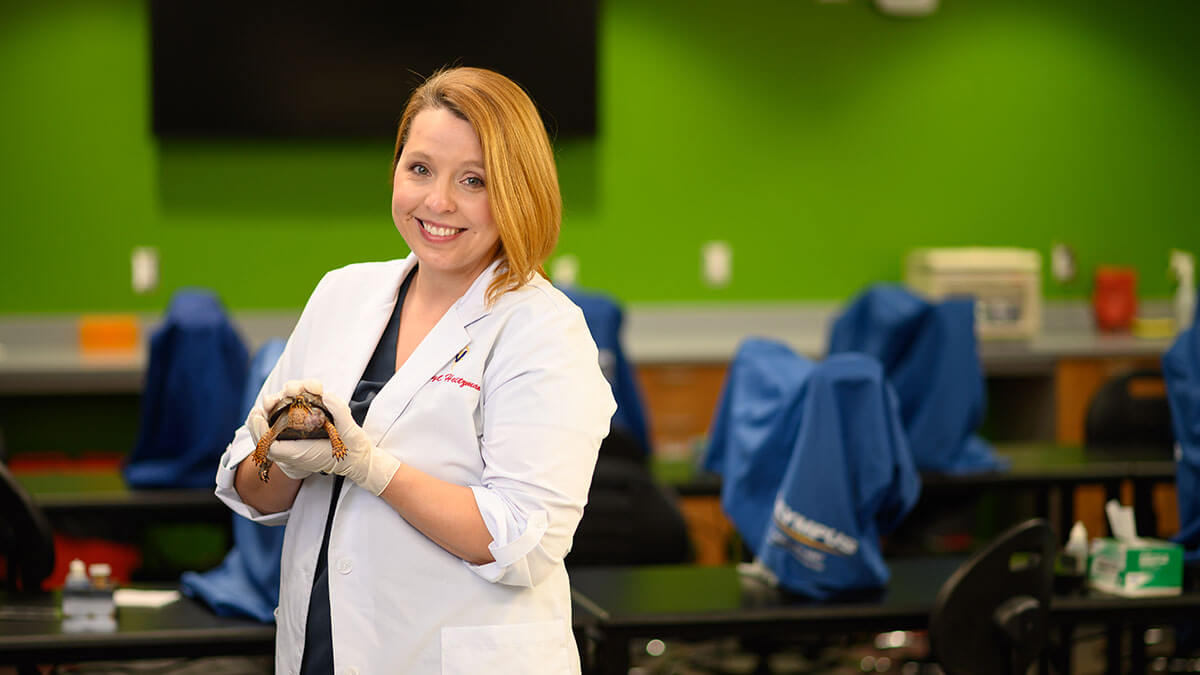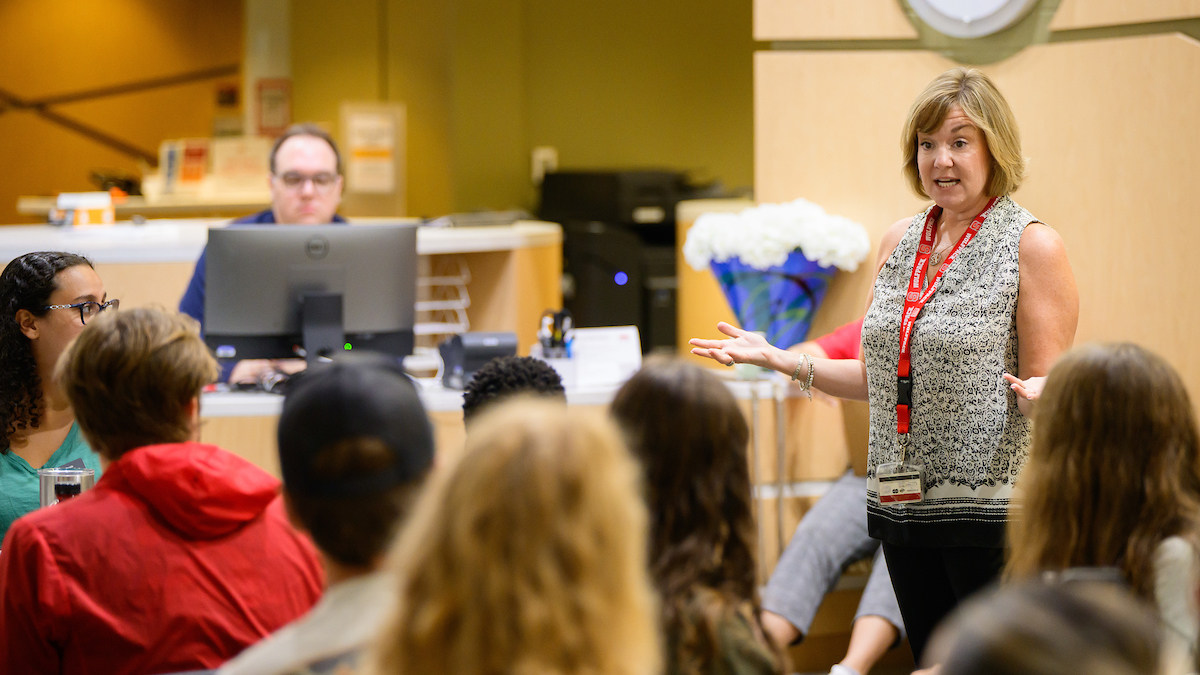A Slow and Steady Race to Save Turtles

Cheryl Heitzman didn’t always live and breathe turtles. The Class of 2021 Turtle Rescue Team co-president didn’t even realize that she wanted to be a veterinarian until she was halfway through a doctoral degree program focused on science education.
Before coming to the NC State College of Veterinary Medicine, Heitzman taught high school and college-level chemistry in Chicago while pursuing her doctorate. She and her husband Ben then moved to Nashville, Tenn., for Ben’s postdoctoral fellowship at Vanderbilt University.
After quitting full-time teaching to finish her degree, Heitzman spent a lot of time writing and working on her thesis. As a way to clear her head and break up her day, she began volunteering at a low-cost spay and neuter clinic and a wildlife shelter.
One night, after a game of trivia at a local bar with her friends from the clinic, one of the veterinarians asked her why she had never thought about becoming a vet. He noticed that she was very interested in everything that they were doing at the clinic and always asked great questions.
“I looked at him and I didn’t have an answer,” she said. “I never thought I could get in or that it would be an option for me.”
She couldn’t shake the question. It stayed with her for weeks.
She began researching her options and about a year and a half later, applied to 11 schools. She was looking for the best option for her growing family. When she attended an academic conference as a teacher back in Chicago, she met some supportive NC State students and faculty from the math and science education department, so NC State was already in her head as a potential option. During her official visit, she decided NC State was her top option.
“This immediately felt like the right place,” Heitzman said.
She chatted with current students and faculty and discovered that there were plenty of people with kids who attended veterinary school, and many even offered child care to her burgeoning baby bump. She could do this. As someone who had always liked turtles, she began volunteering with the Turtle Rescue Team her first year. The more she volunteered, the more she started to come out of her shell and wanted to take on more. She quickly became a treatment lead.
“I learned so much,” she said. “After my time with the Turtle Team, I felt very comfortable going into my second-year surgery and anesthesia classes. It got me thinking like a doctor. I could sit through a lecture and relate things back to cases we’d seen that summer.”
As a volunteer treatment lead, she spent two to three days a week with turtles, now as the co-president she spends almost all of her free time with the Turtle Rescue Team, especially during the summer.
This year the team has 579 patients so far, a record since the student group opened its doors in 1996. At one point during the summer, the lab had a record 96 patients at once, some of them tiny baby turtles that were born in the lab. If female turtles come in and don’t have a good prognosis, the team harvests her eggs, incubates them, hatches and then releases them.
The team takes patients year-round, with most calls beginning in April and May when turtles come out of their winter hibernation. Snapping turtles come out first, followed by water turtles and then Heitzman’s favorite, the box turtle.
“Their faces are so serious and so adorable,” she said.Almost all patients, including turtles, reptiles and amphibians across the state, are brought in by good Samaritans who find them injured as a result of encounters with cars, lawnmowers, weed eaters, dogs and other predators. It’s then a team effort to care for the patients before they are released back into their native habitat. Whether the patients spend a few days or a few months with the team, they are cared for by students, community volunteers, veterinary hospital faculty and staff, local turtle rehabbers and donors who support the team.
“The Turtle Rescue Team wouldn’t work without a ton of people,” Heitzman said. “It takes a whole heck of a lot more than a village. We are beyond grateful for every single person that pitches in to help.”
One person in particular has helped the team grow and take on more patients than ever before. Ashley Kirby is the first Carolyn Glass Turtle Rescue Team Intern, a new position created through donor support from Kerry Glass. Kerry, Carolyn’s mother, helped create the internship as a way to honor her late daughter who was an exotic animal veterinarian interested in conservation. As a CVM Class of 2018 alumna, Kirby spent countless hours volunteering with the Turtle Rescue Team and now oversees their daily operations.
“Ashley’s day-to-day, on-the-ground mentorship and guidance has really elevated the Turtle Team and its mission of saving wild animals, producing scholarly work and teaching the next generation of wildlife veterinarians,” said Greg Lewbart, CVM professor of aquatic animal medicine, Turtle Rescue Team co-founder along with wildlife rehabilitator Linda Henis and one its faculty mentors.
For Heitzman and the rest of the team, she’s a life-saver, not only for the turtles but for them. Whether answering their many questions or mentoring about patient care, the team can’t imagine her ever not being a part of the team.
“Things would be impossible without Dr. Kirby,” Heitzman said. “We love her and can do better medicine now that we have her.”
Heitzman also stressed the key role of her fellow veterinary students. “The volunteers from the Classes of 2022 and 2023 have been especially fantastic, and with their leadership, enthusiasm and fantastic ideas, we are going to have a much easier time taking on an increasingly larger caseload.”The Turtle Rescue Team is also about more than just rescuing and rehabbing turtles. They are also focused on conservation through research. Every patient helps contribute to the overall body of knowledge about the species. By studying turtles and publishing research papers, the group hopes to make a lasting impact for the future of the species. Almost every student member contributes to or leads at least one research study during their tenure.
Heitzman recently studied how a new formulation of an anesthetic affects turtles. “We don’t know a whole lot about turtles,” she said. “Research enriches our understanding of the species in the natural world and drives future innovations.”
As Heitzman thinks about her upcoming fourth year, she acknowledges that her future will come full circle. Next year she will take on a three-week off-campus learning experience at the clinic that inspired her to take a splash into veterinary medicine in Nashville.
“People make all the difference in this field, and I want more people to be able to have the cool experiences I’ve had,” she said.
To learn more about the Turtle Rescue Team, visit their web page.
~Brittany Sweeney/NC State Veterinary Medicine
- Categories:


